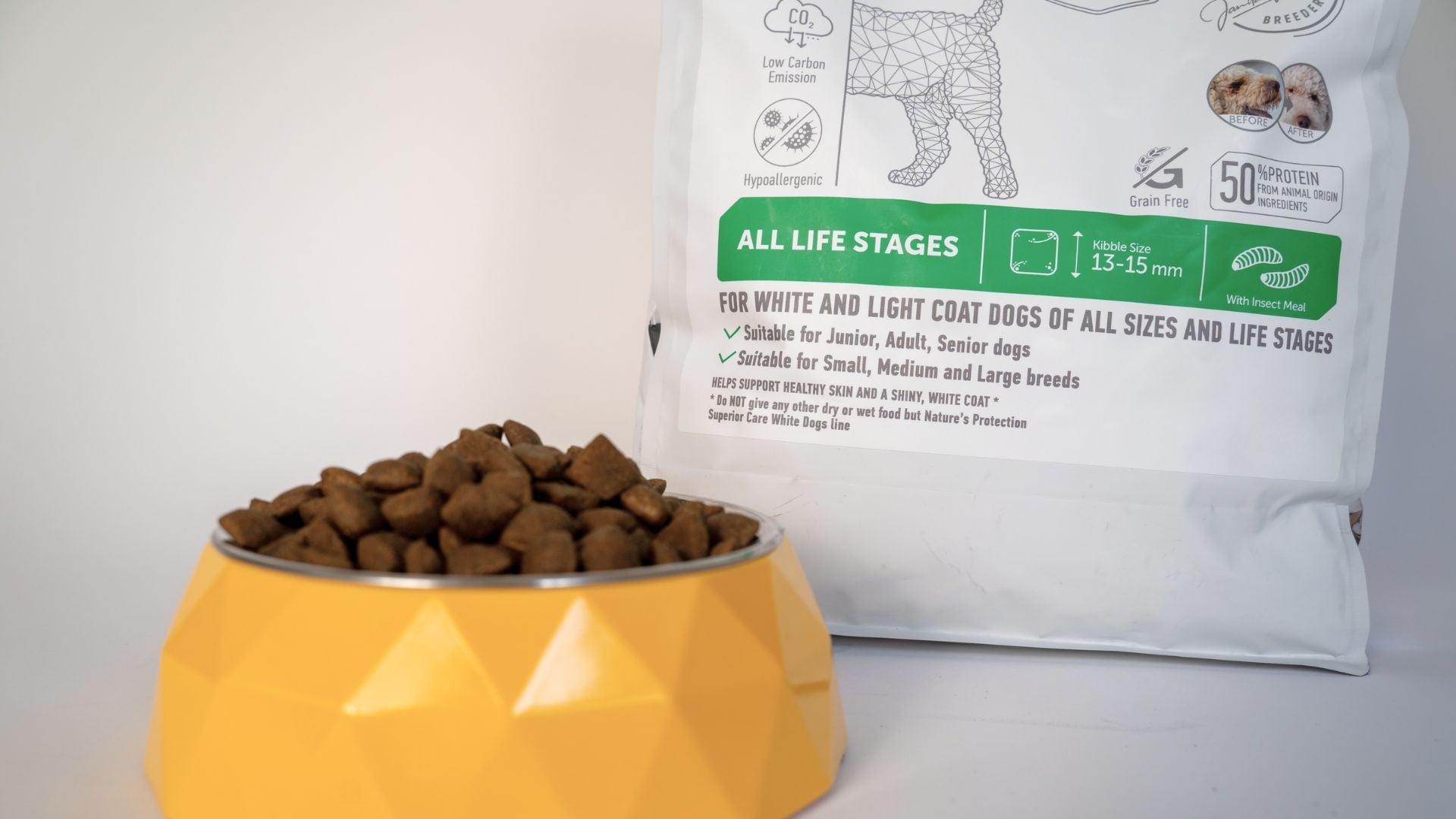With nearly four decades of experience in dog breeding and as the creator of Nature's Protection dog food, I've witnessed the ever-evolving world of pet care. One topic that often stirs debates among dog owners and enthusiasts is the idea of norming food portions for our beloved furry friends.
In this article, we'll dive into the complexities of dog nutrition, debunking misconceptions and unveiling the scientific factors that influence a dog's dietary needs.
The Science Behind Dog Nutrition
When it comes to ensuring the health and well-being of our four-legged friends, understanding dog nutrition is essential. Dogs, much like humans, have unique dietary needs, influenced by various factors.
When it comes to ensuring the health and well-being of our four-legged friends, understanding dog nutrition is essential. Dogs, much like humans, have unique dietary needs, influenced by various factors.
Let's start with age – a critical determinant of nutritional requirements. Puppies, in their early stages, need a diet rich in protein and calories to support their rapid growth and development. As dogs grow, their dietary needs change. Senior dogs, for instance, benefit from a diet tailored to maintain their health as they age.
The dog's breed also plays a significant role in breed-specific nutrition. Larger breeds might require different nutrient ratios compared to smaller ones. Moreover, a dog's size and activity level matter. Active dogs, whether working or simply highly energetic, need diets that provide the right balance of nutrients to fuel their activities. Less active dogs require fewer calories to prevent weight gain.
Furthermore, a dog's health condition, from allergies to sensitivities, might necessitate specialized diets. It's crucial to be mindful of these individual needs.
Nature's Protection Superior Premium dry food has been meticulously designed, considering all these factors. With carefully calculated and balanced nutrient content, it offers dogs the optimal blend of protein, fats, carbohydrates, vitamins, and minerals, considering all their unique requirements. All you need to do is calculate the right amount of the food.
Understanding Portion Recommendations
You might have noticed that many dog food manufacturers and veterinarians provide general feeding guidelines printed on the pet food packaging. These guidelines typically factor in your dog's weight and sometimes their age to suggest a daily portion size. However, it's essential to understand that these are only recommendations, and the ultimate portion size should be tailored to your dog's specific needs to help maintain a stable weight and ensure they receive the right amount of nutrition.
It's crucial to remember that treats should constitute only a small portion, roughly 5%, of your dog's total daily caloric intake. Taking treats into account when planning their daily nutrition is important to maintain the proper balance of calories and nutrients.
Measuring your dog's food portions accurately is made easy with tools like Nature's Protection electronic food scoop. This innovative gadget ensures precision when serving your pet's meals. It allows you to effortlessly portion out their food according to your tailored feeding plan, taking the guesswork out of the process. With this handy device, you can be confident that you're providing your furry friend with the right amount of nutrition to maintain a stable weight and overall health.
Debunking the Myth or Validating the Practice
The concept of "norming" food portions has been a subject of debate among dog owners and experts alike. Proponents of norming argue that it simplifies feeding routines, offers convenience, and helps ensure dogs receive a consistent amount of food daily. It's undoubtedly an attractive idea, particularly if you lead a busy lifestyle.
However, many skeptics question the validity of this practice. They argue that norming doesn't consider the unique dietary needs of individual dogs. Here, the "one size fits all" approach may not be suitable, as dogs differ in age, breed, size, and activity levels. Feeding the same portion to a highly active Border Collie and a laid-back Basset Hound might not be the best strategy.
To shed light on this debate, let's explore some real-world examples and case studies that highlight the successes and failures of norming dog food portions. Consider the following scenarios:
- Success Through Norming: In some households, norming food portions works remarkably well. For instance, if you have multiple dogs of the same breed, age, and activity level, feeding them the same portion might be efficient. In this case, norming ensures consistency, and you can easily monitor their overall well-being.
- Individualized Feeding Needs: On the other hand, there are countless cases where norming doesn't suit all dogs in a household. Let's say you have a senior dog that needs a lower-calorie diet to manage weight and a young, active dog that requires extra energy. Norming portions for both may lead to underfeeding or overfeeding one of them. In such cases, it's crucial to consider each dog's unique dietary requirements.
- Health Conditions: Dogs with specific health conditions might require individualized feeding. For instance, a diabetic dog will need a precise portion to manage their blood sugar levels, while a dog with allergies might require a specialized diet with specific ingredients, which norming might not accommodate.
In these real-world examples, it becomes evident that there is no one-size-fits-all approach to feeding dogs. Norming can work in certain situations, but when it comes to providing dogs with the best possible nutrition for their individual needs, a personalized dog diet tends to be more effective. So, while the concept of norming has its merits, it's essential to recognize its limitations and be open to tailoring your dog's food portions as needed.
Tailoring Portion Sizes for Dogs
One of the key takeaways from the debate surrounding norming food portions is that dogs are not one-size-fits-all creatures when it comes to nutrition. To ensure your furry companion's health and happiness, you'll need to consider various factors to determine and adjust their food portions.
Monitor Body Condition
A fundamental aspect of calculating your dog's portion size is understanding their body condition. Body condition scoring (BCS) is a useful method to evaluate whether your dog is underweight, overweight, or at an ideal body condition. This method considers visual and tactile assessments of your dog's body, including ribs, waistline, and muscle mass.
- Ideal Weight: If your dog's ribs are visible and easily felt with minimal fat cover, and they have a defined waist when viewed from above and the side, they're likely at their ideal weight.
- Underweight: If the ribs, spine, and pelvic bones are highly visible and easily felt with no discernible fat layer, your dog is underweight and may require a larger portion of food to gain some weight.
- Overweight: If your dog lacks a waistline and has a thick layer of fat over the ribs, spine, and base of the tail, they are overweight and may need a smaller food portion to shed extra pounds.
Assessing Lifestyle and Activity
Your dog's daily activities and exercise levels also play a crucial role in determining their portion size. Dogs with higher activity levels, such as working dogs, agility athletes, and those with an active daily routine, will naturally burn more calories and require larger portions. Conversely, less active dogs, like couch potatoes or elderly companions, will need smaller portions to maintain a healthy weight.
Health and Age Considerations
If your dog has specific health conditions or allergies, their dietary needs may differ significantly from the norm. Dogs with conditions like diabetes, allergies, or kidney issues will require specialized diets with careful portion control. Consult your veterinarian to ensure your dog's dietary needs are met.
As dogs age, their nutritional requirements may change. Puppies, adult dogs, and seniors have different energy needs, which means their portion sizes may also need adjustment. For instance, puppies need more calories for growth, while senior dogs may benefit from fewer calories to maintain a healthy weight.
Regular Vet Check-ups
One of the most effective ways to ensure your dog's portion sizes are appropriate for their needs is through regular vet check-ups. Your veterinarian can assess your dog's overall health, identify any specific requirements, and provide guidance on the right portion sizes to maintain an ideal weight.
By keeping an eye on your dog's body condition, activity level, age, and health status, you can tailor their portion sizes to ensure they receive the right amount of nutrition. The key is to acknowledge the diversity among dogs and their unique dietary needs. With this approach, you can provide your loyal companion with the best possible nutrition and help them maintain a happy, healthy life.
Summary
As we wrap up our exploration of dog nutrition and portion control, it's essential to emphasize the importance of those feeding guidelines you'll find on your pet food's packaging. These guidelines provide a valuable starting point, considering factors like your dog's weight and sometimes their age. However, it's crucial to understand that these are only general veterinary recommendations. The final portion size should depend on your dog's specific needs to ensure they maintain a stable weight and stay in optimal health. By combining these initial guidelines with careful observation and, when necessary, consulting your veterinarian, you can create a diet that caters to your furry friend's unique needs, ultimately promoting their health and overall well-being.












